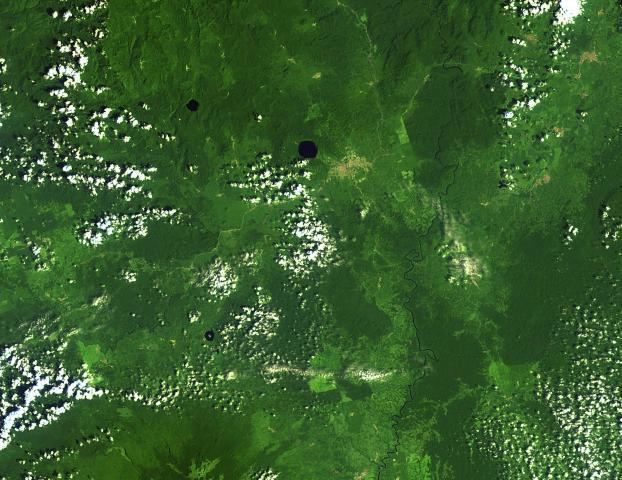Type Crater lake Max. length 2.2 km (1.4 mi) Surface elevation 110 m Mean depth 3.8 m Width 2 km | Max. width 2 km (1.2 mi) Area 3.3 km² Length 2.2 km | |
 | ||
Primary inflows Primary outflows Nkundung-Kotto Stream (dries out or greatly reduced in dry season), which is a tributary of the Meme River | ||
Lake Barombi Koto, also known as Lake Barombi Kotto or Lake Barombi-ba-Kotto, is a small lake in the volcanic chain in the Southwest Region of Cameroon. It is a volcanic lake with a diameter of about 1.2 km (0.75 mi). There is a small island in the middle, which is densely inhabited by the Barombi, a tribe of fishers. The Tung Nsuia and Tung Nsuria streams, each about 1–2 m (3 ft 3 in–6 ft 7 in) wide and 0.3 m (1 ft 0 in) deep near their mouth, are the only inflows into the lake, and they dry out in dry season.
Contents
Map of Lake Barombi Koto, Cameroon
Lake Barombi Koto often appears green-brown because it is rich in phytoplankton. Invertebrates, turtles and the aquatic frog Xenopus tropicalis are common in the lake, which is also an important sanctuary for birds. Seven fish species are known from the lake, including Barbus callipterus and a Clarias catfish, while the remaining all are cichlids: Coptodon kottae, Chromidotilapia guentheri, Hemichromis fasciatus, Pelmatolapia mariae and Sarotherodon galilaeus. Of these, C. guentheri is represented by the endemic subspecies loennbergi, while C. kottae is entirely endemic to this lake and the smaller Lake Mboandong. Both endemics are threatened by pollution and sedimentation from human activities, and "turning" of the lake's water because of deforestation of the surroundings (this may allow more wind, and the lake is stratified with oxygen-poor lower levels). They are potentially also threatened by large emissions of carbon dioxide from the lake's bottom (compare Lake Nyos).
The nothobranchiids Aphyosemion bivittatum, Epiplatys sexfasciatus and Fundulopanchax oeseri, the poeciliid Procatopus similis, and Barbus callipterus are found in the Tung Nsuia and Tung Nsuria streams.
Bulinus snails (including the near-endemic B. camerunensis) infested with Schistosoma, which causes the disease bilharzia in humans, are present in the lake.
Lake Mboandong
About 1 km (0.62 mi) south of Lake Barombi Koto is the even smaller Lake Mboandong, another shallow crater lake with a diameter of about 0.4 km (0.25 mi). There is no inflow and the only outflow is a small stream during the wet season.
Lake Mboandong is less rich in phytoplankton and has less fish species, but all are species shared with Lake Barombi Koto and its inflowing streams: Aphyosemion bivittatum, Fundulopanchax oeseri, Coptodon kottae, Hemichromis fasciatus and Sarotherodon galilaeus. Members of the Barombi tribe that live at Lake Barombi Koto sometimes visit Lake Mboandong to fish.
